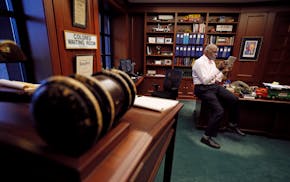When Teddy Roosevelt looked upon the Grand Canyon as president in 1903, the barrel-chested adventurer and war hero said the site "fills me with awe." He implored his fellow man, "Do nothing to mar its grandeur, sublimity and loveliness."
His words were apparently ignored by a herd of bison.
As many as 500 bison, which can stand six feet tall and weigh 2,000 pounds, have recently taken up full-time residence in the northern part of Grand Canyon National Park and are causing havoc with the area's ecosystem, say park officials, who want to reduce the herd to 200.
Now for the first time, they are planning to let a small number of volunteers kill bison inside the park.
More than 45,000 people had applied for 12 slots by the deadline last week. Each person selected gets to kill one bison during the program, which is expected to begin in the fall. The rest of the herd reduction is expected to be achieved by capturing and relocating live bison and through state-run hunts that take place outside the park.
Twenty-five finalists will be announced later this month, and the first 12 who submit complete, accurate and qualified applications will be selected, said Kaitlyn Thomas, a spokeswoman with the National Park Service.
Volunteers must be in good physical health, pass a marksmanship proficiency test and be "willing to haul bison carcasses out of wilderness on foot without motorized assistance," according to the National Park Service.
The herd is in an area that is managed as if it is designated wilderness, Thomas said. That means stock animals and motorized vehicles are not permitted, she said. "And we are not willing to violate the management practices that we already have in place."
Hence, the requirement that applicants be physically fit. "We're talking about walking perhaps miles with 100 pounds per person in a pack, above 8,000 feet of elevation," Thomas said. "So it will be very strenuous work."
The area of the park where the hunt will take place, known as the North Rim, is full of tall ponderosa pine, quaking aspen trees and pools of water. "If you were standing even 100 yards from the Grand Canyon, you wouldn't know that the canyon is there," Thomas said. "You would just assume that you were in an Alpine valley."
Park officials say the bison have altered vegetation patterns, damaged archaeologically valuable sites and even threatened the water supply for animals and humans in the Grand Canyon.
"You'll see them wading in the pools, munching grass next to the pool, just having a great time," Thomas said. "They don't generally go somewhere else to go to the bathroom, so they'll just go right there," leading to E. coli contamination, she said.
There were an estimated 30 million to 60 million bison in North America in the 1500s, according to the Park Service. By the 1800s, the figure had dropped to about 400. Conservation efforts helped restore the numbers, and there are currently an estimated 500,000 bison throughout North America, according to the Park Service.
The herd in Grand Canyon National Park is believed to be made up of direct descendants of the bison introduced to the area by Charles Jones, known as Buffalo Jones, in the 1900s "as a ranching experiment to crossbreed bison and cattle," according to the Park Service. The venture failed, and the bison migrated to the south end of the House Rock Valley area. In 1927, the herd was sold to the Arizona Game and Fish Department.
By the 1990s, hunting and fires in the area had led some in the herd to migrate back into Grand Canyon National Park, officials said. For a while, the herd wandered between the park and the area now known as the House Rock Wildlife Area. Since 2009, most of the bison have settled down within the park.
"The bison, they've become relatively aware of the fact that when they go beyond the park boundary, they are at risk from the state-led hunt," Thomas said. "So that's why you often see them almost exclusively ranging inside that small area."
Without intervention, the herd could triple in size, to around 1,500, within a decade, officials said. If it were to do so, the damage would multiply, officials said.
Once a bison is killed, the state of Arizona will donate the carcass to the volunteer. Any part not used by the volunteer will be donated "to our traditionally associated tribes for traditional use," Thomas said. "We didn't want to waste these bison."
Thomas spoke from her home in the South Rim on Thursday night. A pair of elk crashed through the trees outside her window as she explained what might have drawn so many people to the chance to lethally remove so few bison in the North Rim, which is really no different from the areas where more than 100 bison were already hunted.
"I think it's just the name Grand Canyon National Park," she said.

Twins lose second in a row to Blue Jays as bullpen falters late
What is the 'House settlement,' and what does it mean for the Gophers and NCAA?

Souhan: Anxiety and depression in the NFL helped inspire Lindsey Young's children's book

Twins pitcher Ober struggling to regain fastball velocity



